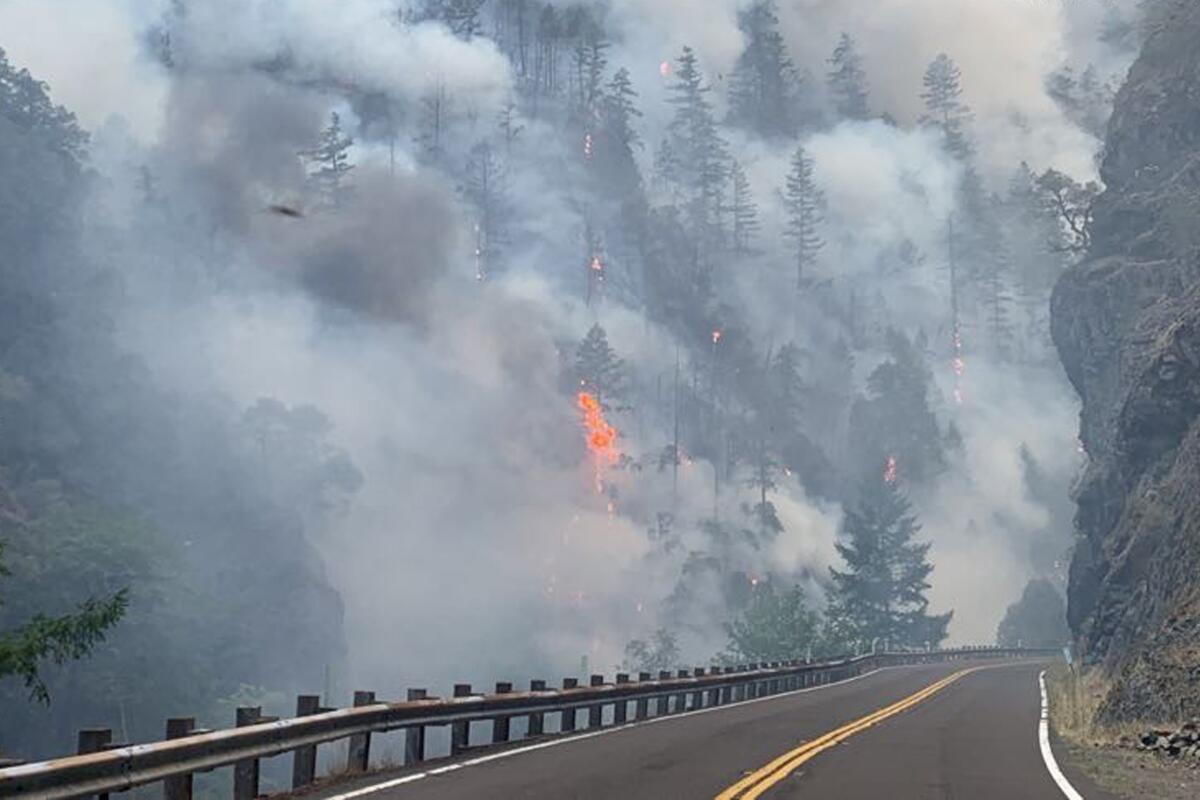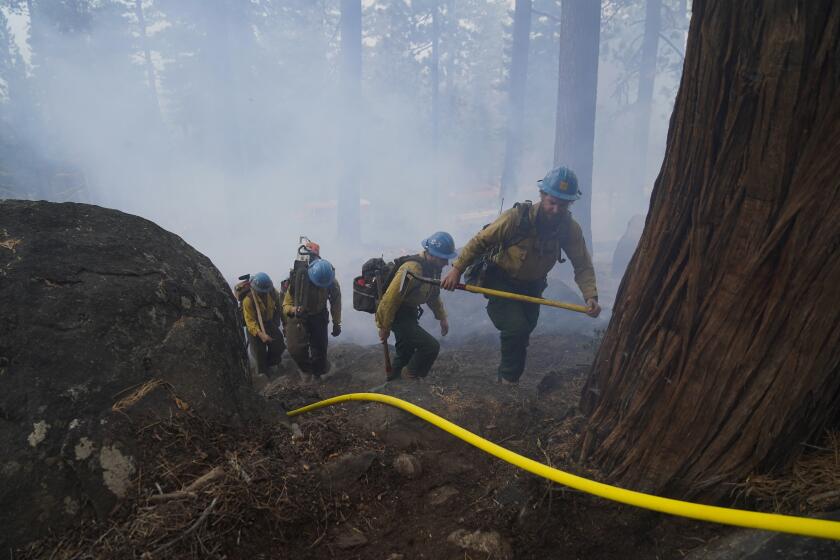Wildfire crews forced to pause after gasoline and diesel fuel mix-up

- Share via
One of the largest wildfires of the season was raging across California’s far northern Del Norte County recently, when firefighters suddenly began issuing distress calls about mysterious equipment failures.
One told the base camp manager that his truck had broken down.
Another reported that his dash warning lights were coming on.
A third said smoke was rising from his vehicle.
In what one veteran fire captain described as a once-in-a-career blunder that very nearly paralyzed operations throughout the Smith River Complex fire, scores of vehicles were filled with the wrong type of fuel.
Wildfires knocked out power to an entire California county. The unprecedented fight to bring it back
With power lines threatened for weeks by fires on the North Coast, officials formed what appears to be California’s largest and longest-running microgrid powered by generators.
At least 82 vehicles were found to have been filled with gasoline instead of diesel fuel, or vice versa, forcing authorities to declare a tactical pause that halted operations across the 181-mile fire complex for two hours on Sept. 8. Some firefighters were stranded on the fire line, and dozens of vehicles needed to be towed from the field and serviced.
“We’re looking down the road at a very expensive mistake,” said Bill Morse, public information officer for Southwest Area Incident Management Team 2.
A post on the Hotshot Wakeup, which first reported the mix-up, described it as a “California nightmare” that could indicate the need for improved vetting of service contractors. But Morse said it was a human error that anyone could have made — albeit one that will probably result in costly litigation.
After he began to receive the calls, the manager of Gasquet base camp inspected the camp’s two fuel tenders — trucks that dispense fuel to firefighting vehicles. The trucks, which typically hold about 4,000 gallons, often have two separate tanks, one for diesel and one for gasoline, Morse said. The manager found that one of the tenders, which was owned by a contractor, had diesel in its gasoline tank and gasoline in its diesel tank, Morse said.
The manager notified the incident commanders, who declared what’s called an incident within an incident. The move triggered a tightly choreographed chain of events in which one representative from each section of the incident management team convened in a war room to tackle the mix-up separately from the main fire, said Morse, who was the public information officer assigned to the group.
The team reviewed the fuel log. It learned that some parts of the fire’s emergency medical response apparatus were affected, including ambulances and rapid extrication modules that would be needed to rescue and treat firefighters in the event of an emergency, Morse said. It became clear that it was not safe for operations to continue, as the mix-up had compromised authorities’ ability to respond to injured firefighters, he said.
The order for a tactical pause went out on the main radio at 4:07 p.m. All 2,000-plus firefighters were told to immediately stop what they were doing and, if they were driving, to pull over and turn off their vehicles, Morse said.
The team called out to each firefighting unit to ask whether they were having problems with their vehicles. About 42 said they were.

Operations resumed at 6 p.m., when the night shift crews that were not affected by the fueling mix-up took over, Morse said.
“Time-wise and as far as the impact on our operations, we took a two-hour lunch,” he said.
The pause came at as opportune a time as any, he said. The fire, which was sparked by lightning Aug. 15, had burned nearly 86,000 acres and was 19% contained. But there was no active firefighting taking place, as recent rains had put a damper on fire behavior, Morse said.
“The work that was being done was on indirect fire line — preparing lines away from the fire’s edge so that when the fire behavior conditions improved enough, we’d be able to burn that space between the line and the fire’s edge,” he said.
Once operations were back up and running, the team turned its attention to getting stranded firefighters off the fire line, Morse said. They arranged for national emergency rental vehicles to pick them up and bring them back to base camp so they could get meals and bed down. Some chose to spike out — or camp in place — overnight, he said.
“Quite typically, hotshot crews are self-sufficient,” he said. “They will typically turn down a ride.”
A federal firefighter’s viral resignation letter is highlighting the job’s low pay and harsh working conditions in the age of climate change.
The next phase was to deal with the broken-down vehicles that were strewn across the fire. Those owned by the Forest Service were towed in, Morse said. The agency also offered to tow and service the vehicles owned by private contractors, but some declined, he said.
In all, 24 vehicles were hauled to the southern incident command post in Crescent City. There, they pumped the fuel tanks into 55-gallon drums and had a hazardous waste disposal company take them away, he said. An additional 18 vehicles were driven to the nearest camp.
Once the fuel was offloaded, the vehicles were serviced by Forest Service heavy equipment mechanics, Morse said.
The former wildland firefighter and captain with the Flagstaff Fire Department described the incident as surprising and said it was a first in his 45-year career. At the same time, he said, it’s a good example of how quickly incident management teams can resolve a problem by working together.
“This had the potential of being very, very challenging for the incident,” he said. “Fortunately, it really wasn’t.”
More to Read
Sign up for Essential California
The most important California stories and recommendations in your inbox every morning.
You may occasionally receive promotional content from the Los Angeles Times.















